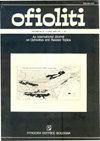Amasia和Stepanavan亚蛇绿质变质单元(亚美尼亚西北部、小高加索)的P-T-T历史:对变质基底发育和逆冲过程的影响
IF 1.3
4区 地球科学
Q2 GEOLOGY
引用次数: 8
摘要
Sevan Akera缝合带蛇绿岩是一个巨大的蛇绿推覆体的遗迹,该推覆体证明了新特提斯洋壳北支在南亚美尼亚/陶里德大陆块上发生了一次长达300公里的大型逆冲事件。在Amasia地区(亚美尼亚西北部)附近,含石榴石的角闪岩保存在绿片岩相构造混杂岩单元内,该单元位于非变质斜交洋单元下方。石榴石角闪岩表现出两种共生体:(1)石榴石-角闪岩-斜长石-花岗母岩,沿S1叶理强烈折叠结晶,在退变质和S2变形过程中重结晶为绿帘石-绿泥石-多辉石。S1和S2变形阶段具有由上向南的韧性剪切作用,解释为蛇绿岩推覆体在逆冲过程中的运动。热气压测量揭示了具有两个P-T场的变质历史:(1)角闪岩阶段,T=600±20°C,6≤P≤7kbar,然后是(2)绿片阶,T=350±30°C,1.25≤P≤4.5kbar。在角闪石和白色云母上进行的40 Ar/39 Ar测年在88-92±2 Ma的误差范围内得出相似的年龄。在金红石上进行的U-Pb测年得出90.2±5.2 Ma的年龄。这些结果得到了斯捷潘纳万以东40公里处类似结构位置的新的和预先存在的岩性特征的补充。在那里,新鉴定的榴辉岩产生了T=575±25°C和17.5≤P≤20kbar的变质条件。这些变质单元的P-T-T历史证明了一个快速的构造过程,其特征是在相对较热的海洋岩石圈下进行洋内俯冲,对覆盖的洋域进行切片,沿着俯冲带的上盘对这种俯冲物质进行底侵,并形成作为“反冲通道”一部分的变质基底。本文章由计算机程序翻译,如有差异,请以英文原文为准。
P-T-T history of the Amasia and Stepanavan sub-ophiolitic metamorphic units (NW Armenia, Lesser Caucasus): implications for metamorphic sole development and for the obduction process
The Sevan-Akera suture zone ophiolites are relics of a vast ophiolitic nappe which testifies a major obduction event, up to 300 km of horizontal transport, of the northern branch of Neotethys oceanic crust over the South Armenian/Taurides continental block. Near the locality of Amasia (NW Armenia), garnet-bearing amphibolites are preserved within a greenschist facies tectonic melange unit located below the non-metamorphic obducted oceanic unit. The garnet amphibolites show two parageneses: (1) garnet-amphibole-plagioclase granoblasts which crystallized along the S 1 foliation intensely folded and recrystallized into (2) epidote-chlorite-phengite during retrogression and S 2 deformation. S 1 and S 2 deformation stages feature top-to-the-South ductile shearing, interpreted as the motion of the ophiolite nappe during obduction. Thermobarometry reveals a metamorphic history with two P-T fields: (1) an amphibolite stage, T = 600 ± 20°C and 6 ≤P ≤7 kbar,followed by (2) a greenschiststage, T = 350 ± 30°C and 1.25 ≤P ≤4.5 kbar. 40 Ar/ 39 Ar dating on amphiboles and white micas yields similar within-error ages of 88-92 ± 2 Ma. U-Pb dating on rutile yields an age of 90.2 ± 5.2 Ma. These results are complemented by new and pre-existing characterizations of lithologies in a similar structural position 40 km east, in the locality of Stepanavan. There, newly identified eclogite yield metamorphic conditions of T = 575 ± 25 °C and 17.5 ≤P ≤20 kbar.The P-T-t history of these metamorphic units argues for a rapid tectonic process featuring intra-oceanic subduction below a relatively hot oceanic lithosphere, slicing of the overriding oceanic domain, underplating of this subducted material along the hanging wall of the subduction zone and formation of a metamorphic sole as part of an ‘obduction channel’.
求助全文
通过发布文献求助,成功后即可免费获取论文全文。
去求助
来源期刊

Ofioliti
地学-地质学
CiteScore
2.40
自引率
7.70%
发文量
1
期刊介绍:
Since 1976, Ofioliti provides an international forum for original contributions and reviews in the field of the geodynamics, petrology, geochemistry, biostratigraphy, stratigraphy, tectonics and paleogeography applied to ophiolitic terrains and modern oceanic lithosphere, including their sedimentary cover. Studies of topics such as geodynamics of the mantle, the evolution of orogens including ophiolites and paleoceanography are also welcome
 求助内容:
求助内容: 应助结果提醒方式:
应助结果提醒方式:


